Observation Notes:
In my ongoing effort to refine my observation and sketches of M42/43, I made a new sketch on January 14. I used most of the previously sketched star field as a starting point so I could spend more time on the nebula. Working within a larger 6 inch circle really helped. The minty green color was striking throughout the nebula, particularly around the trapezium. As for structure, the sketch pretty much tells the story, except for the fact that there was a lot more detail to be squeezed out. I can tell that I’ll be coming back again and again for more.
Object Information:
The Orion Nebula lies 1500 to 1600 light years away and is the brightest diffuse nebula in the sky. It is the brightest portion of a much larger cloud of gas and dust which extends over an area of 10 degrees. This cloud also contains Barnard’s Loop, the Horsehead Nebula and the reflection nebula around M78. The brilliant M42 extends to a diameter of 30 light years.
The incredible complexity of the nebula is so great that various aspects of it have been given some creative names. Some of the more prominent are:
Fish’s Mouth = the dark lane extending from the north into the brightest portion of the nebula
Wings = the bright regions to both sides
Trapezium cluster = the bright cluster of stars pointed to by the Fish’s Mouth
The Sword = the wing extension to the south on the east
The Thrust = the bright nebulosity below the Trapezium
The Sail = the fainter western extension
The Hubble Space Telescope discovered dark, protoplanetary discs called Proplyds around the region of the Trapezium. These investigations have shown that the blazing radiation of the Trapezium stars is eroding the Proplyds so that the lower-mass stars forming there may not maintain enough material to form planetary systems.
M42 was discovered by Nicholas-Claude Fabri de Peiresc in 1610, but it seems strange that its nebulosity was not discovered sooner, since it is easily visible to the naked eye. Charles Messier cataloged it in 1769.

| Subject | M42 (NGC 1976) / M43 (1982) |
| Classification | Diffuse Nebulae |
| Position | Orion: M42: [RA: 05 35 17.2 / Dec: -05 23 27]* M43: [05 35 31.3 / Dec.: -05 16 03] |
| Size* | M42: 90′ x 60′ / M43: 20′ x 15′ |
| Brightness* | M42: 4.0 bMag / M43: 9.0 bMag |
| Date/Time | January 14, 2010 – 10:00 AM (January 15, 2010 05:00 UT) |
| Observing Loc. | Cinder Hills Overlook, Sunset Crater National Monument, AZ |
| Instrument | Orion SkyQuest XT8 Dobsonian (203 mm dia./1200 mm F/L) |
| Eyepieces/Mag. | 32 mm (37.5X) |
| Seeing | 5/10 Pickering |
| Transparency | Mag 7+ NELM |
| *Sources | DSS; NGCIC Project; SEDS |
*Based on published data.
October 22, 2006 Observation:
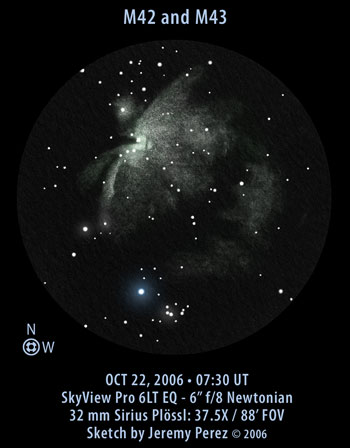
Click image for larger version.
Observation Notes:
I’ve been looking forward to making another low-power sketch of this beauty. It continues to amaze me that the patch around the trapezium is so boxy. There is a break on the west edge of this patch, which brightens again on the other side. The northwest side of the larger extent of the nebula is the brightest. The southern wing has a nice sharp edge with a hook that points inward. After fading out to the southwest, there is some patchy brightening that subtly picks up again. I noted a minty green color that was strongest in the trapezium box, but extended subtly through the other bright portions of the nebula.
After having some trouble with the regular sketch paper I used on 2006/M4 (SWAN) earlier in the evening, I used a nice, sturdy sheet of smooth bristol for this sketch. It worked very nicely and took multiple layers of graphite without resistance. I did feel that my standard 3″ sketch circle is not big enough for the amount of fine detail available in this object. I may need to consider a 5″ circle for some objects in the future. The sketch took an hour and a half to complete and contains 103 stars.
| Date/Time | October 22, 2006 – 12:30 AM (October 22, 07:30 UT) |
| Observing Loc. | Cinder Hills Overlook, Sunset Crater National Monument, AZ |
| Instrument | Orion SVP 6LT Reflector (150 mm dia./1200 mm F/L) |
| Eyepieces/Mag. | 32 mm (37.5X) |
| Seeing | 5/10 Pickering |
| Transparency | Mag 6.8 NELM |
December 12, 2004 Observation
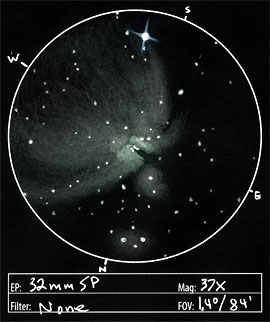
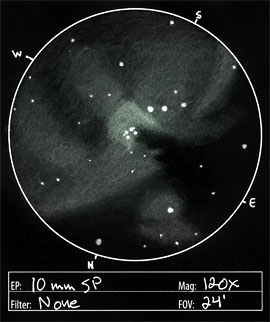
Observation Notes:
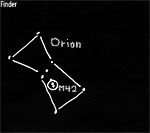 Boy, I was fighting fogged eyepieces on this one. For this first sketch of M42, I decided to go without the Ultrablock filter. It still looked great. One common comparison is that it looks like a bird, but the way the ‘wings’ of the nebula are swept back reminded me more of: A) a Shadow Vessel from Babylon-5, B) a face hugger from Alien, C) a brine shrimp. Heh. Man that’s not flattering for such a beautiful nebula. It was bright, and minty green in the lightest area.
Boy, I was fighting fogged eyepieces on this one. For this first sketch of M42, I decided to go without the Ultrablock filter. It still looked great. One common comparison is that it looks like a bird, but the way the ‘wings’ of the nebula are swept back reminded me more of: A) a Shadow Vessel from Babylon-5, B) a face hugger from Alien, C) a brine shrimp. Heh. Man that’s not flattering for such a beautiful nebula. It was bright, and minty green in the lightest area.
When I viewed it yesterday in Bill’s 18″ dobsonian, it was a great aqua green with a sliver of salmon pink along the linear south edge of the trapezium pocket. It was so detailed, it looked like a dark storm cloud lit from within by a great bolt of lightning–setting its innards on fire in brilliant, ominous 3-D.
Back to my scope…the notch that flowed toward the trapezium from the east looked like a mitten reaching into a bright pocket to snatch the brilliant stars within. The larger, more diffuse interior of the nebula seemed brightest along the northern region. The outer boundary of the ‘wings’ on the eastern edge was gilded brighter than the rest of the inside…except for the trapezium pocket which is the brightest. I could just make out the E and F stars at 120X. The F star was very tightly bound to its bright companion. M43 punctuated the northeast section of the view with its comma outline.
M42 is also catalogued as LBN 974, Sh2-281, h 360, and GC 1179. M43 is also catalogued as H III-1, GC 1185, CED 55G.
| Date/Time | December 12, 2004 – 1:00 AM December 12, 2004 – 08:00 UT |
| Observing Loc. | Flagstaff, AZ – Home |
| Instrument | Orion SVP 6LT Reflector (150 mm dia./1200 mm F/L) |
| Eyepieces/Mag. | 32 mm (37.5X); 10 mm (120X) |
| Seeing | 5/10 Pickering |
| Transparency | Mag 5.8 NELM |
*Based on published data.
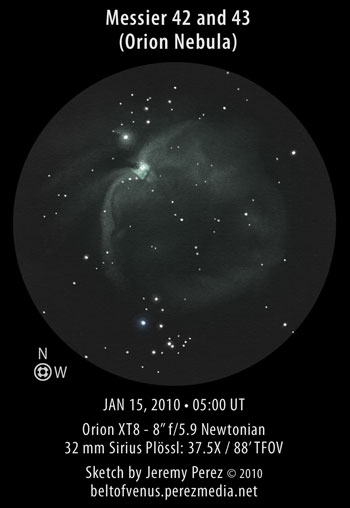
thanks for the information… Orions belt was so clear tonight and I have always wondered what the two stars at 7 o’clock were. now i know.
again thanks…
Jeremy,
I love seeing all your sketches of these objects in one place. Your current effort is the best of the best! The scope you used is actually one of my favorites, the XT8 and the eyepiece was/is still a wide field favorite the 32mm Plossl though my 32mm Q70 gives a good view in the XT8. Your use of color in stars and the nebula is wonderful, a good lesson in being subtle while still conveying the color. Just fabulous.
Thanks Jay. I could definitely use a better low power eyepiece…the Plossl displays a lot of coma away from the center half of the field. I’m pretty slow to acquire new pieces of equipment, so it’s hard to say when I’ll take care of that little piece of business 🙂